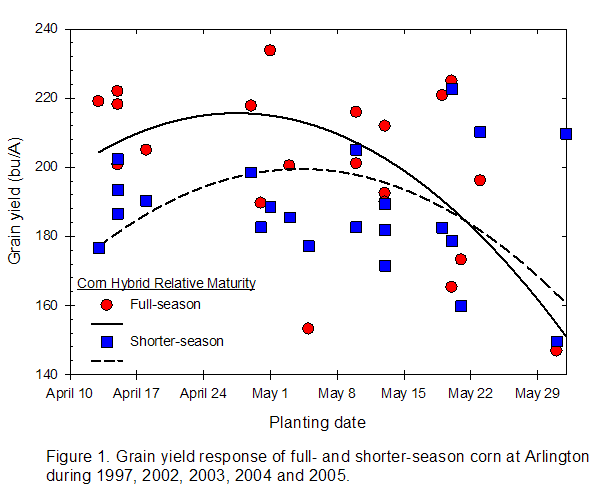Dates to Switch Hybrid Relative Maturity to Maximize Grain Yield
Joe Lauer, Corn Agronomist
For the week ending May 15 about 75% of the corn acres were planted in Wisconsin
(USDA Statistics). About 1 million acres are still intended to be planted. Traditionally,
as May 20 approaches, farmers start switching to shorter-season relative maturities
of hybrids.
Factors that need to be considered when making this decision are: 1) knowing the
correct full-season maturity that a field can handle, 2) grain price, and 3) fuel
costs for grain drying after harvest. Understanding how to pick the correct maturity
for a field is difficult. Farmers usually spread risk by selecting a few hybrids
of different maturities and planting these hybrids across fields on their farm.
The realistic grain price will vary depending upon the producer's ability to market
grain. Corn grain used on-farm as livestock feed should be valued at the price it
would cost to purchase. Fuel costs will be influenced by market supply and demand,
the farmer's purchasing power, and his ability to negotiate and haggle over price.
Many factors influence full-season hybrid relative maturity. Some factors are genetic,
others are environmental, and still others are influenced by management. Also, no
common method for rating relative maturity of hybrids exists among seed companies.
So, any recommendations for switching hybrid maturity during late-May must be made
in general terms.
This article evaluates the planting date response of shorter-season hybrids and
builds upon an article published a few weeks ago describing planting date response
of full-season hybrids between 1997 and 2005 (http://corn.agronomy.wisc.edu/WCM/W183.aspx).
In all years, two or more hybrids were grown that differed for RM by 7 or more days.
But, for four years (1998-2001), all hybrids grown were greater than 102 days RM,
which is considered full-season at the Arlington location. Thus, no shorter-season
hybrids were grown during 1998-2001 and no comparisons are made.
Figure 1 shows the relationship between full- and shorter-season hybrids at Arlington
where a full-season hybrid is > 102 days RM. In most years, corn grain yield
decreases as planting date is delayed (Figure 1). Full-season hybrids provide the
best yield potential until ~May 20, when hybrids 7 days RM or more shorter-season
begin to produce greater yield. So, by ~May 20, corn hybrid maturity should be switched
to 98 days RM or less at Arlington.
In the previous article, full-season hybrids (grown during 1997, 2002-2005) produced
a maximum grain yield of 206 bu/A on April 20. Yields were still within 95% of the
maximum grain yield until May 20.
Grain yield potential of shorter-season hybrids is lower than full-season hybrids.
The maximum yield of shorter-season hybrids was 190 bu/A produced April 23 (Table
1). Yields were still within 95% of the maximum yield until May 26. Thus, the planting
date that produces maximum yield is not very different between full- and shorter-season
corn hybrids (April 20 v. April 23). Shorter-season hybrids remain within 95% of
their maximum yield about 6 days later into May (May 20 v. May 26). In these years
(1997, 2002-2005), the best date to switch hybrid relative maturity from full- to
shorter-season to maximize grain yield was May 21 at Arlington.
Table 1. Planting date response of shorter-season corn hybrids
(<100 d RM) at Arlington, WI .
|
|
Year
|
First
treatment
|
Grain yield
|
|
Pattern
|
Maximum
|
Maximum
|
Window
|
|
|
Date
|
|
Bu/A
|
Date
|
Date
|
|
1997
|
April 18
|
+L-Q
|
198
|
April 25
|
May 21
|
|
1998
|
All hybrids grown in experiment were full-season for Arlington
|
|
1999
|
All hybrids grown in experiment were full-season for Arlington
|
|
2000
|
All hybrids grown in experiment were full-season for Arlington
|
|
2001
|
All hybrids grown in experiment were full-season for Arlington
|
|
2002
|
April 15
|
None
|
177
|
April 15
|
June 9
|
|
2003
|
April 15
|
-Q
|
195
|
April 15
|
May 9
|
|
2004
|
April 12
|
+L-Q
|
192
|
April 30
|
May 12
|
|
2005
|
April 15
|
None
|
190
|
April 15
|
June 15
|
|
Average
|
April 15
|
+L-Q
|
190
|
April 23
|
May 26
|
Window = Last planting date where grain yield is within 95% of the maximum
yield or grower return is within 95% of the economic optimum.
|
